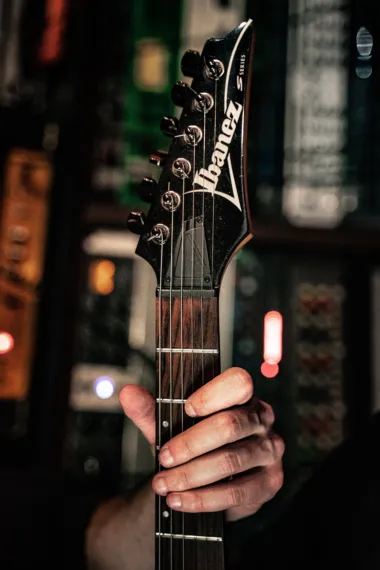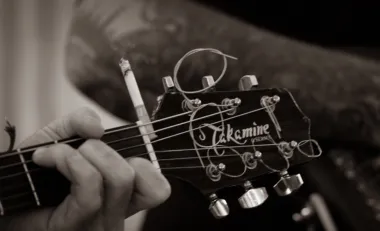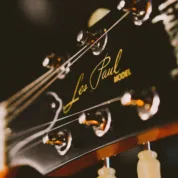
Are you a passionate guitarist eager to keep your instrument in tip-top shape?
If you're a working or gigging guitarist, or aspire to be one, maintaining your guitar is an essential part of your journey, and trimming those pesky guitar strings should be a frequent part of it. In this article we explore the ins and outs of this seemingly simple yet often overlooked task. With a few insightful tips, this guide will have you mastering the art of string cutting in no time.
At Band Pioneer, we understand that being a musician is about more than just honing your craft—it's also about getting good advice, tips, and learning how to market your music effectively. That's why we're committed to providing you with as much insight as possible, to help you make money as a musician and achieve success in your musical endeavors.
Whether you're a seasoned professional or just starting, this article covers everything from the tools you'll need to alternative methods for when you're in a pinch. We've even included a few tips on properly cutting your strings to ensure you look great, sound great, and have as few mishaps a possible when it's showtime. So, grab your favorite axe and let's start cutting those guitar strings like a pro!
Why You Should Cut Your Guitar Strings
As a guitarist, you're on a never-ending quest to achieve the perfect sound. One essential step in your journey is knowing how to cut your guitar strings. While it may seem like a trivial task, it can significantly impact your instrument's performance and longevity.
- Look like a Pro!
Cutting your guitar strings ensures that you maintain a clean, polished look. Neatly trimmed strings prevent unnecessary clutter and help you avoid any embarrassing moments on stage when an uncut string gets caught on your clothes or gear. - Play like a Pro!
Cutting your strings can enhance your instrument's playability. When the excess string is removed, it reduces the chance of the string ends getting tangled, which can lead to tuning issues and other complications. By keeping your strings short and tidy, you can prevent unwanted interference while playing. - Pro-long Your Guitars Life
Proper string trimming can extend the life of your guitar's hardware. When strings are not cut correctly, they can create tension on the tuning pegs, leading to potential damage. By trimming your strings, you'll be taking care of your guitar and ensuring it continues to bring you musical joy for years to come.


What to Use to Cut Guitar Strings
Choosing the right tools for cutting guitar strings is crucial for ensuring a smooth and efficient process. The ideal tools not only provide precision and ease of use but also minimize the risk of damage to your instrument or injury to yourself. Guitar string cutters, cutting pliers, and precision wire cutters are among the top choices for this task, each offering unique advantages.
Guitar string cutters are specially designed for the purpose of trimming strings, making them a reliable and convenient option. Cutting pliers, while not specifically intended for guitar string cutting, can be versatile and highly effective if used correctly. Precision wire cutters, also known as flush cutters or electronics cutters, are great for precise cuts and reaching tight spaces, making them a useful alternative.
All three tools have the benefit of being widely available and easy to handle, ensuring a safe and precise cutting experience for every guitarist. Selecting the most suitable tool will depend on your preferences and the specific requirements of your instrument.
1. Guitar String Cutters
Guitar string cutters are specifically designed for musicians and their unique needs. These handy tools often come with additional features, such as a built-in string winder and bridge pin puller, making them a versatile and valuable addition to your guitar maintenance toolkit.
The primary advantage of using a guitar string cutter is the precision it offers. The sharp, curved cutting edge allows you to trim strings closely without risking damage to your guitar's finish. Additionally, these cutters are built to withstand the rigors of frequent use, ensuring longevity and consistent performance.
While guitar string cutters can be slightly more expensive than regular pliers, the convenience and accuracy they provide make them a worthwhile investment for dedicated guitarists.
2. Cutting Pliers
Alternatively, cutting pliers can also be used to trim guitar strings. These general-purpose tools are more affordable and can be found in most hardware stores. While they may not have the specialized features of dedicated guitar string cutters, they can still get the job done.
When using cutting pliers, make sure to choose a pair with sharp edges to ensure a clean cut. It's also important to exercise caution when cutting close to your guitar's surface, as the pliers' design could potentially scratch the finish if you're not careful.
Although cutting pliers may not be as convenient or precise as guitar string cutters, they can be a cost-effective option for beginners or those who only need to cut strings occasionally. Whichever tool you choose, make sure to prioritize your guitar's safety and the quality of the cut.
3. Precision Wire Cutters
Precision wire cutters, also known as flush cutters or electronics cutters, are another option for cutting guitar strings. These cutters are typically used in electronics and jewelry making but can be repurposed for guitar string cutting due to their sharp cutting edges and precise control. The slim, needle-nose design allows for easy access to hard-to-reach areas around the tuning pegs.
When using precision wire cutters, make sure to hold the string firmly to prevent whipping and avoid cutting at an angle to minimize the risk of damaging the string or your guitar. Remember, always exercise caution when using sharp tools to protect yourself and your instrument.
How to Cut Guitar Strings Without Wire Cutters
There might be situations where you don't have access to wire cutters or guitar string cutters. Fear not! There are alternative methods for cutting guitar strings using everyday items. In this section, we'll explore how to use scissors, nail clippers, pocket knives, and even your fingers to trim your strings.
4. Scissors
Scissors can be a useful tool for cutting guitar strings in a pinch. Opt for a pair with sharp blades and a fine point, as this will help you make precise cuts. To avoid accidentally scratching your guitar, carefully position the scissor blades around the string, leaving a small gap between the scissors and the instrument's surface. Apply firm pressure to cut through the string. Be aware that using scissors may dull the blades over time, so designate a pair specifically for this purpose or use a different method when possible.
5. Nail Clippers
Nail clippers might seem like an unconventional choice, but they can be surprisingly effective at cutting guitar strings. Their small size and sharp cutting edge make them suitable for this task, especially for thinner strings. To use nail clippers, simply open the jaws, position them around the string close to the tuning peg, and apply pressure until the string is severed.
Keep in mind that nail clippers might not be the most efficient option for thicker strings, as they can require more force to cut and may become damaged. Additionally, exercise caution to avoid scratching your guitar's surface, as the clipper's edges can be sharp.
6. Pocket Knife
A pocket knife can also serve as a makeshift guitar string cutter. This method works best with a sharp, serrated blade, as it allows for better grip and a cleaner cut. Carefully saw through the string using a back-and-forth motion, ensuring you maintain a safe distance from your guitar's surface to prevent any damage. While this method may take a bit more time and effort, it can be effective when other tools are not available. Remember to exercise caution and handle the pocket knife responsibly to avoid injury.
7. Using Your Fingers
Believe it or not, you can even use your fingers to cut guitar strings! However, this method should be reserved as a last resort and is recommended only for thinner strings. To begin, carefully bend the string back and forth in a rapid motion at the point where you want to cut it. This action will generate heat due to the friction, eventually causing the string to break. Be prepared for the possibility of sore fingers, as this technique requires significant effort. It's also important to remember that this method may leave a jagged edge on the string, so handle with care.
Tips For Properly Cutting Guitar Strings
Cutting guitar strings may seem straightforward, but there are some best practices to ensure optimal results. In this section, we'll share four tips to help you cut your strings properly: determining the ideal length, cutting excess strings, maintaining your instrument, and protecting your guitar's finish. By following these guidelines, you'll be able to give your guitar the TLC it deserves while keeping it in top-notch condition.

How Long to Cut Guitar Strings
Determining the right length for your guitar strings is crucial to maintain optimal playability and prevent hardware damage. As a general rule, you should leave approximately 2-3 inches of excess string beyond the tuning peg. This allows for enough slack to wrap around the peg while avoiding excessive tension. For guitars with slotted headstocks, such as classical guitars, leave about 1-2 inches of excess string. By ensuring your strings are cut at the appropriate length, you'll help maintain your guitar's tuning stability and avoid undue stress on its components.
How to Cut Excess Guitar Strings
When cutting excess guitar strings, it's important to minimize the risk of damage to your instrument's finish and hardware. To do this, make sure to leave a small gap between your cutting tool and the guitar's surface, avoiding direct contact. Hold the string firmly while cutting to prevent it from whipping or snapping, which could cause injury or damage to your guitar.
Once the string is cut, carefully bend the remaining string end downward, so it doesn't stick out and create a hazard. Depending on your hardware, you may also be able to tuck the excess string down into the tuning posts, or, wrap it underneath the wound string so that the sharp ends are completely unexposed.
By taking these precautions, you'll protect your hands and arms, and your guitar's finish, to ensure a clean and professional appearance.
Final Thoughts
Now that you're equipped with the knowledge and tips for cutting guitar strings, you're well on your way to maintaining your instrument and achieving that perfect sound. Remember to use the appropriate tools for the job and always exercise caution to protect your guitar's finish and hardware. Maintaining your guitar not only helps it look and sound its best but also contributes to its longevity.
For more advice and tips like this, be sure to read Band Pioneer weekly. We're constantly researching the music industry and fielding questions from our readers, so that we can put out the must useful articles every week. And we're constantly developing new website features, to help our users navigate this crazy world of music, from honing your skills to marketing your music effectively. Our goal is to not only help you become a better musician, but also a profitable one! Subscribe now and let Band Pioneer guide you on your journey to musical stardom.







Leave a Reply!
One thing this article seems to miss is the fact that many guitar strings are made from quite hard steel. Using cutters intended to cut copper wire (electronics cutters, or similar) will quickly damage the cutting surfaces. This is particularly true when cutting strings that are in the order of 0.05 inches thick.
There's an ex-GF joke in here somewhere, lol!!
OK, I thought how can this article possibly teach me anything about such an easy task. But there's more to it then I thought! lol. Love the digging into areas I hadn't thought much about.